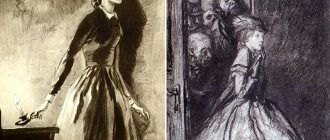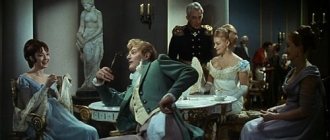- Essays
- On literature
- Other
- The image and characterization of Julien Sorel in Stendhal's novel Red and Black
Julien Sorel is an independent, self-respecting young man who passionately desires to change his destiny in any way. He is smart, handsome and terribly charming. The hero is the son of a carpenter, he does not want to put up with the fate prepared for him and tries in every possible way to escape from his environment.
The young man was attracted to military service. He always looked up to Napoleon. Those around him disliked him, because he dreamed of a big career and was not like his brothers. And yet the main character challenges society, finding himself surrounded by influential people.
Arriving at the house of M. de Renal, Julien was obsessed with ambitious plans. There he behaved in such a way that all the roads to his dream were open to him. Everything was not sincere on his part - his attitude towards Madame de Renal, who truly loved him, towards her children and husband. Julien, with the help of an influential family, wanted to take a strong position in society, to gain its respect, provided that he would be recognized as a full-fledged person, an extraordinary person, talented, gifted, intelligent, strong.
Julien combines two personalities - a proud man and an ambitious man, but at the same time a kind and spontaneous person, childishly naive. As he overcame ambition and pride, he ceased to be attracted to the proud and ambitious Matilda. Now he considered all the merits of the selfless Madame de Renal, who loved him sincerely. As a result, Julien began to reach out to her more.
Having been imprisoned for the attempt on the life of Madame de Renal, Julien realizes that he is no longer accused of the crime he committed, but because he dared to break the rules according to which he, a person from the lower strata, has no right to enter that world. to which he does not belong from birth. This act predetermined the sad fate of the young man. He was sentenced to death.
Thus, Julien’s victory over his own vices led to his death. The main character didn't even try to save himself. He resigned himself to his fate. Julien Sorel was unable to rebuild himself and overcome his delusions. Bourgeois society was no longer for him, and he did not want to live in the lower classes. Having realized everything, Julien has lost the meaning in life, so the guillotine is his only salvation. Julien Sorel was unable to rebuild himself and overcome his delusions. Bourgeois society was no longer for him, and he did not want to live in the lower classes.
Julien Sorel and other characters in the novel “The Red and the Black”
In his novel “Red and Black,” Stendhal created an objective picture of the life of his contemporary society. “The truth, the bitter truth,” he says in the epigraph to the first part of the work. And he adheres to this bitter truth until the last pages. The author's just anger, decisive criticism, and caustic satire are directed against the tyranny of state power, religion, and privileges. The entire system of images created by the writer is subordinated to this goal. These are the inhabitants of the province: the nobility, the bourgeoisie, the clergy, the philistinism, the justice of the peace and representatives of the highest aristocracy.
The novel is actually divided into three parts, each describing the life and customs of individual class groups: Verrieres - a fictional provincial town, Besançon with its seminary and Paris - the personification of high society. The intensity of the action increases more and more as events move from the provinces to Besançon and Paris, but the same values dominate everywhere - personal interest and money. The main characters appear before us: de Renal is an aristocrat who married for a dowry and tried to withstand the competition of the aggressive bourgeois. He started a factory, like them, but at the end of the novel he has to give in in the fight, because Valno becomes the mayor of the city, who “collected the very trash from every craft” and suggested to them: “Let’s reign together.” The author shows through this image that it was gentlemen like Valno who became a social and political force in his time. And the Marquis de La Mole accepts this ignoramus, a provincial swindler, hoping for his help during the elections. Stendhal also reveals the main trends in the development of society, in which the aristocracy and clergy strive with all their might to retain power. To do this, they start a conspiracy, the essence of which the writer reveals in an ironic epigraph: “The fundamental law for everything that exists is to survive, to survive. You sow tares and hope to bring forth ears of grain.” The characteristics that Julien Sorel gives to them are eloquent: one of them is “totally absorbed in his digestion”, another is full of “the anger of a wild boar”, the third looks like a “wind-up doll”... All of them are ordinary figures who, according to Julien, are “afraid, as if he didn’t make them laugh.”
Criticizing and ridiculing the political aspirations of the bourgeoisie, the author also directs his irony at the clergy. Answering his question about what is the meaning of the activity of a clergyman, Julien comes to the conclusion that this meaning is “to sell believers places in heaven.” Stendhal openly calls existence in a seminary, where future spiritual mentors of the people are trained, disgusting, since hypocrisy reigns there, thought is combined with crime. It is no coincidence that Abbot Pirard calls the clergy “lackeys necessary for the salvation of the soul.” Without hiding the slightest detail of the life of a society where “the oppression of moral suffocation” reigns and where “the slightest living thought seems rude,” the author draws the system of social relations in France at the beginning of the 19th century. And this chronicle does not evoke sympathy at all.
Of course, Stendhal does not deny his heroes the ability to think, suffer, and obey not only profit. He also shows us living people, such as Fouquet, who lives far from the city, the Marquis de La Mole, who is able to see personality in a poor secretary, Abbot Pirard, whom even his friends did not believe that he did not steal as rector of the seminary, Matilda, Madame de Renal and, first of all, Julien Sorel himself. The images of Madame de Renal and Mathilde play a very important role in the development of events. That’s why the author pays special attention to them, showing how society and the environment broke their souls. Madame de Renal is sincere, honest, a little simple-minded and naive. But the environment in which she exists forces her to lie. She remains the wife of de Renal, whom she despises, realizing that it is not she herself who is valuable to him, but her money. Proud and proud Matilda, convinced of her superiority over people only because she is the daughter of the marquis, is the complete opposite of Madame de Renal. She is often cruel and merciless in her judgments of people and insults the plebeian Julien, forcing him to invent ingenious means to subjugate her. But there is something that brings her closer to the first heroine - Matilda, although rationally and not instinctively, also strives for a sincere feeling of love.
Thus, the pictures of social life created by Stendhal gradually lead us to the idea of how “dull” the time described is, and how petty and insignificant people become under the influence of this time, even those who are naturally endowed with not so bad qualities.





